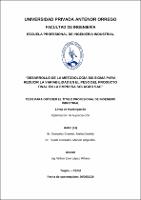Desarrollo de la metodología Six Sigma para reducir la variabilidad en el peso del producto final en la Empresa Solagro SAC

View/
Download
(application/pdf: 5.505Mb)
(application/pdf: 5.505Mb)
Date
2020Author(s)
González Graterol, María Daniela
Tejada Gonzales, Manuel Alejandro
Metadata
Show full item recordAbstract
La presente tesis plantea una propuesta para mejorar el proceso de pesado de
producto terminado de la empresa SOLAGRO SAC usando como referencia la
metodología Six Sigma. La estructura que aquí se presenta sigue el esquema
DMAIC, donde se define el problema, se mide el proceso, se analiza la causa raíz,
se mejora el proceso con propuestas que atacan la causa, y por último se controla
el mismo por medio de KPI´s. Se realizó un análisis riguroso para poder identificar
los puntos críticos en el proceso de pesado de producto terminado; encontrando
como tal, falta de procedimientos estándares, problemas en procesos anteriores
que afectaban directamente al proceso final, aunado al uso de herramientas de
pesado inadecuadas para la labor realizada. Las sumas de estos factores han
causado gran variabilidad en el peso, una de las características de calidad que
están ligadas directamente al proceso de negocio y a la satisfacción al cliente. El
diagnóstico inicial arrojó valores de medio igual a 0.798 kg, desviación estándar
0.00649 kg, rango de variabilidad de 4.13% y una proporción de defectuosos de
87.3%, ubicando al proceso con un nivel sigma entre 1.7 y 1.8. Mediante el uso de
distintas herramientas usadas la metodología six sigma, especialmente ligadas al
control estadístico, además de las propuestas de mejora para el control y reducción
de variabilidad se obtuvieron resultados que apuntan al objetivo principal de la tesis:
se obtuvo una media de 0.800 kg, la ideal; una desviación estándar de 0.00178kg;
un rango de variabilidad del peso de 1.63%, y solo 43% de defectuosos; ubicando
al proceso en un nuevo nivel sigma entre 2.2 y 2.3. Por lo tanto se concluye que
desarrollando la metodología six sigma se logra una disminución en la variabilidad
del peso del producto terminado; y para lograr el nivel máximo o niveles superiores
sigma es necesario el compromiso de gerencia y de las áreas competentes, ya que
de ellos depende que las mejoras y el control avancen y den paso a la optimización
del proceso en busca de una mayor satisfacción de los clientes, logrando disminuir
la variabilidad de la calidad de sus procesos y productos terminados. This thesis presents a proposal to improve weighing finished products process of
the company SOLAGRO SAC using the Six Sigma methodology as a reference.
The structure presented here follows the DMAIC scheme, where the problem is
defined, the process is measured, the root cause is analyzed, the process is
improved with proposals that attack the cause, and finally it is controlled by KPI's. A
rigorous analysis was carried out in order to identify the critical points in the process
of weighing the finished product; finding as such, a lack of standard procedures,
problems in previous processes that directly affected the final process, together with
the use of inadequate weighing tools. The sum of these factors has caused great
variability in the final product weight, one of the quality characteristics that are
directly linked to the business process and customer satisfaction. The initial
diagnosis showed average ratio equal to 0.798 kg, standard deviation ratio equal to
0.00649 kg, variability range ratio equal to 4.13% and a defective products
proportion equal to 87.3%, placing the process with a sigma level between 1.7 and
1.8. Through the use of different tools used in the six sigma methodology, especially
linked to statistical control, in addition to the proposals for improvement in the control
and reduction of variability, results were obtained that point to the main objective of
the thesis: an average ratio of 0.800 kg was obtained, the ideal; a standard deviation
of 0.00178 kg; a range of variability of the weight of 1.63%, and only 43% of
defective products were detected; placing the process in a new sigma level between
2.2 and 2.3. Therefore, it is concluded that by developing the six sigma
methodology, a decrease in the variability of the weight of the finished product is
achieved; and to achieve the maximum level or higher sigma levels, the commitment
of the management and the competent areas is necessary, since it depends on them
that the improvements and the control advance and give way to the optimization of
the process in search of a greater satisfaction of the clients, achieving a decrease
in the variability of the quality of their processes and finished products.
Collections
- Ingeniería Industrial [356]

